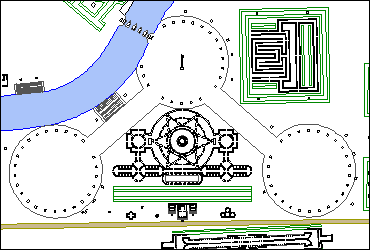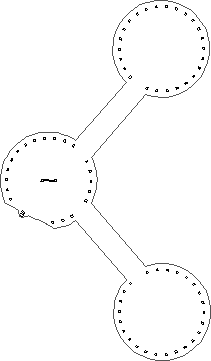Circulus
Ludus
1998.12.01
circulus : a circular figure; a circle
Ludi : public games, plays, spectacles, shows, exhibitions, which were given in honor of the gods, etc.
ludus : a place of exercise or practice
|
The three large Circulus of the Ichnographia occur between the left bank of the Tiber and the west side of the Equiria, within the northern-most region of the large plan. These circular planes are connected by two Ludus, which are military parade grounds. Essentially, the three Circulus, the two Ludus, and the many Statuae Virorum illustrium (statues of illustrious men) constitute Piranesi's rendition of ancient Rome's formal setting for its military parades and exercises. These broad open areas, along with the activities they facilitate, comply fully with the Equiria's overall character as ancient Rome's military headquarters and as a tribute to Mars. Moreover, placement of the Officinae Armorum and the Officinae machinarum militarium right in the center of the parade fields further reinforces the military specificity of Piranesi's design intention.

Fasolo, a mid-twentieth century art historian, criticized the Circulus and Officinae Armorum complex as "a triangular and star-shaped system to which it is certainly not possible to find a comparison in classical typology." Although Fasolo's observation is correct, it is nonetheless unfortunate that he did not recognize the overriding "Martian honor" theme of Piranesi's Equiria design. Furthermore, Fasolo failed to detect the pattern of inversion Piranesi employs throughout the Ichnographia, particularly with regard to the large plan's archeological and historical inconsistencies, and, in this case, the circular and triangular formation of Piranesi's parade grounds may well represent an inverted delineation of ancient Rome's real military grounds, the huge square shaped Praetorian Camp, which was in an altogether different section of the city.
| |

Circulus with Ludus and Statuae Virorum illustrium
The three Circulus of the Ichnographia are large circular planes, each almost 1000 feet in diameter and decorated with Statuae Virorum illustrium (statues of illustrious men) along their perimeters. The two outer circles are connected to the inner circle by two Ludus (places for public games, etc.).
|
| |
Equiria
1998.12.01
The buildings along the Equiria related to the military are: the Officinae Balistarium, the Officinae Scorpiorium, the Templum Castrum, the Naumachia Domitiani, three Circulus with two Ludus, the Officinae Armorum with its attached Officinae machinarum militarium, the Templa Jovis Martis Veneris, and an Aedicula Isidis, all of which translate into a ballista factory, a scorpion factory, a temple dedicated to Castor (the guide to mariners), a stadium for the show of mock sea-fights, exercise fields, a factory for arms and military machines, and a triple temple dedicated to Jupiter, Mars, and Venus and chapel dedicated to Isis. These buildings, moreover, are interspersed with "statues of illustrious men" as well as the sepulchers of many distinguished military figures from Roman history. This concentration of military functions essentially constitutes a design for ancient Rome's main military headquarters.
|

